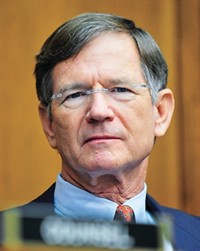Advertisement
Grab your lab coat. Let's get started
Welcome!
Welcome!
Create an account below to get 6 C&EN articles per month, receive newsletters and more - all free.
It seems this is your first time logging in online. Please enter the following information to continue.
As an ACS member you automatically get access to this site. All we need is few more details to create your reading experience.
Not you? Sign in with a different account.
Not you? Sign in with a different account.
ERROR 1
ERROR 1
ERROR 2
ERROR 2
ERROR 2
ERROR 2
ERROR 2
Password and Confirm password must match.
If you have an ACS member number, please enter it here so we can link this account to your membership. (optional)
ERROR 2
ACS values your privacy. By submitting your information, you are gaining access to C&EN and subscribing to our weekly newsletter. We use the information you provide to make your reading experience better, and we will never sell your data to third party members.
Research Funding
NSF to get more money and a new directorate
But how much money and exactly when remain to be seen
by Jyoti Madhusoodanan, special to C&EN
June 3, 2021
| A version of this story appeared in
Volume 99, Issue 21

The US National Science Foundation appears set to receive a large funding increase and a new technology directorate in the near future—although just how much money will be involved remains to be worked out among the House of Representatives, Senate, and White House.
All those bodies have proposals in the works to beef up the NSF, which funds about 25% of all federally funded basic research in the US. But its budget—$8.5 billion for fiscal 2021—has had only minimal increases over the past several years—far smaller on a percentage basis than the National Institutes of Health, for example.
NSF’s existing directorates
▸ Biological Sciences
▸ Computer and Information Science and Engineering
▸ Education and Human Resources
▸ Engineering
▸ Geosciences
▸ Mathematical and Physical Sciences
▸ Social, Behavioral, and Economic Sciences.
“NSF is a sort of beacon for all innovation in the country,” says biological engineer Subra Suresh, who was the NSF director from 2010 to 2013 and is now president of Nanyang Technological University. “From that perspective, an increase to NSF funding is long overdue.”
The Senate’s proposal is furthest along, as it’s packaged within the US Innovation and Competition Act (S.1260), formerly known as the Endless Frontiers Act, which Senators passed in a bipartisan vote on June 8. The package is “intended to help address the rising military, geopolitical, and economic competition from China,” according to a statement by the Republican Policy Committee, and it is a priority of majority leader Chuck Schumer (D-NY). It would increase the NSF’s funding by a whopping $81 billion over the next 5 years, including $29 billion for a Directorate for Technology and Innovation. That directorate would support projects in 10 focus areas, including materials science and engineering, quantum computing, and artificial intelligence and machine learning.
The act also earmarks $10 billion to create regional technology hubs across the country. “If we’re going to make this big investment in big technologies, we want to ensure there’s geographic diversity and success,” says Deborah Altenburg, associate vice president for research policy and government affairs at the Association of Public and Land-grant Universities. “As a nation, it doesn’t serve us well to only have the coasts participating in these efforts.”
The House proposal, the National Science Foundation for the Future Act (H.R.2225), is more modest in both its vision and its budget. The bill as it currently stands offers a budget increase of $1 billion each year for the next 5 years. It also establishes a Directorate for Science and Engineering Solutions. But the reined-in budget and other provisions aim to ensure that the new directorate won’t supersede the NSF’s core directorates and their missions. “The House bill is more in line with what I’d consider the traditional activities of NSF,” says Tim Clancy, president of Arch Street, a Washington, DC–based strategic consulting firm.
Clancy adds that the two bills differ in their philosophies of how the NSF should fund various activities: while the House bill relies on traditional peer review, the Senate’s pushes for alternative ways to fund outside peer review, akin to the Defense Advanced Research Projects Agency.
And then there’s the White House’s approach, contained in President Joe Biden’s budget request to Congress for fiscal 2022. That sets out $10.2 billion for the NSF, including $865 million for a Directorate for Technology, Innovation, and Partnerships intended to “serve as a cross-cutting platform that leverages, energizes, and rapidly brings to the market and to society the innovations that result from all of NSF’s investments,” the request says. The dollar amounts suggest that the White House is more aligned with the House of Representatives in not wanting the new directorate to supplant existing ones.
New directorate focus areas
The US Innovation and Competition Act (S.1260) proposes establishing a new Directorate for Technology and Innovation focused on the following:
▸ Artificial intelligence, machine learning, and other software advances
▸ High-performance computing, semiconductors, and advanced computer hardware
▸ Quantum computing and information systems
▸ Robotics, automation, and advanced manufacturing
▸ Natural and anthropogenic disaster prevention or mitigation
▸ Advanced communications technology
▸ Biotechnology, medical technology, genomics, and synthetic biology
▸ Cybersecurity, data storage, and data management technologies
▸ Advanced energy, batteries, and industrial efficiency
▸ Advanced materials science, engineering, and exploration relevant to the other key technology focus areas.
Regardless of how much money a new technology directorate gets, such an addition to the NSF, which has traditionally focused on basic science, might make some researchers nervous. But applied technologies have always been part of the agency’s mission, according to Michigan State University chemist Angela Wilson. She led the NSF’s Chemistry Division from 2016 to 2018 and is now president-elect of the American Chemical Society, which publishes C&EN. “A lot of basic science does translate to technology, so having this funding is really going to encourage universities to enhance their tech-transfer programs, work in partnership with industry, and provide a lot of exciting incentives to researchers,” she says.
Such efforts have typically been the purview of the NSF’s Directorate for Engineering, but Wilson says a new directorate would encourage scientists across all disciplines to think about applications of their work. “It’s really important that we do train the new generation of chemists to be thinking about the entrepreneurial and sustainability aspects of their work,” she says.
The proposed increases in funds available to core programs supported by the NSF’s seven existing directorates are also both crucial and exciting, Wilson says. Over her 2 decades in chemistry research, she says, “the amount of funding has stayed the same, but the cost of research has gone up as well as indirect costs,” such as utilities and administration.
Suresh contrasts the NSF’s budget with the science budgets of other countries. “Whether you compare against a populous country like China or a tiny nation like Singapore, at both extremes there’s enormous investment in R&D at a time when NSF budget increases have lagged,” he says.
The House of Representatives, Senate, and White House will have to agree on what to do with the NSF, as a bill can’t become law without approval from both legislative bodies and the president’s signature.
Some people are concerned about the Senate bill leading the way, given its restrictive provisions concerning intellectual property that might limit collaboration or international recruitment. Policies that subject international scientists or graduate students to additional scrutiny or constraints could seem unwelcoming to global talent, Altenburg says. “We’re sort of nervous about all of the different permutations of research security and amendments” offered in the legislation, she says. “Much of the US’s success in scientific research is that we’ve been able to recruit the best minds and they have wanted to stay in the US. We still want it to be a welcoming environment.”
It is likely to be several months before all the details are sorted out, Altenburg and Clancy say. And they caution against getting too excited about politicians’ proposals. “A lot of hopes and dreams are dashed by budgetary realities,” Clancy says. “Ultimately, any amount is going to be tied to the state of the overall discretionary spending.”
Update
This story was revised on June 9, 2021, to reflect that the US Senate passed the US Innovation and Competition Act on June 8, 2021.





Join the conversation
Contact the reporter
Submit a Letter to the Editor for publication
Engage with us on Twitter